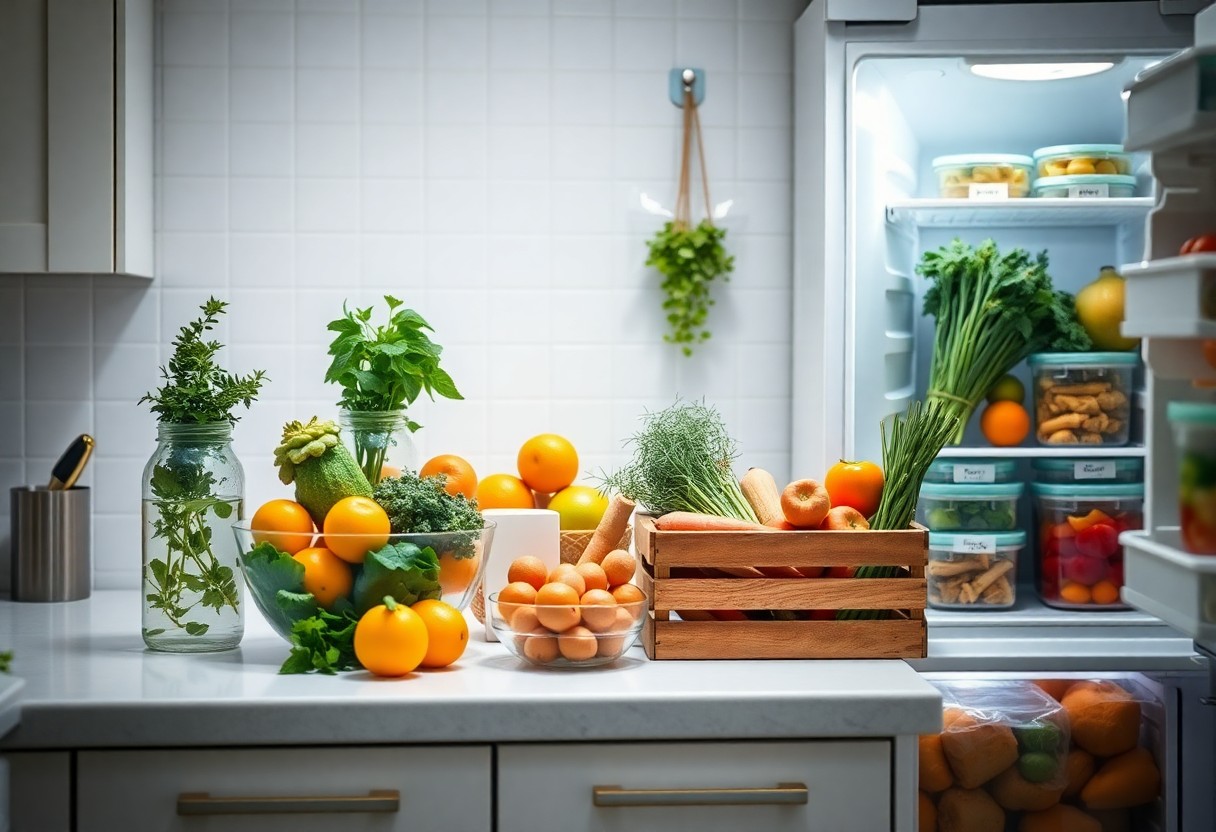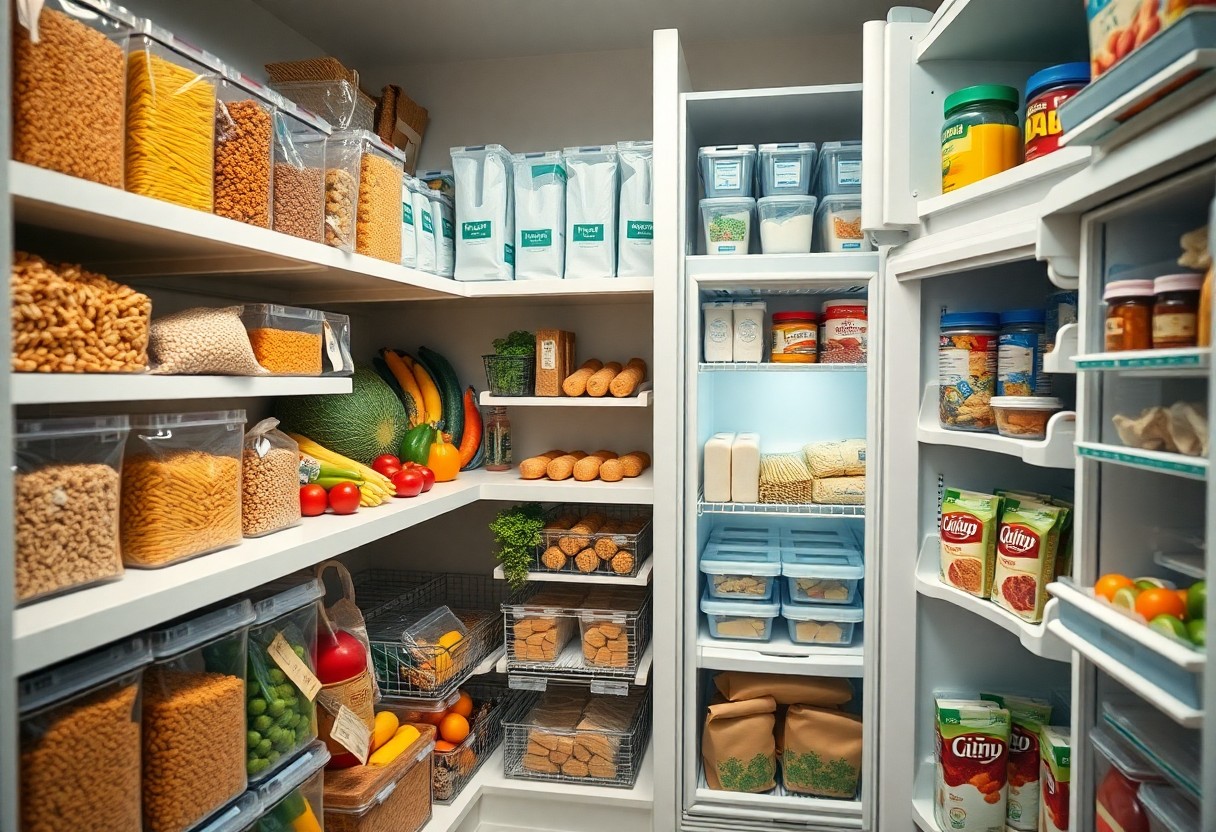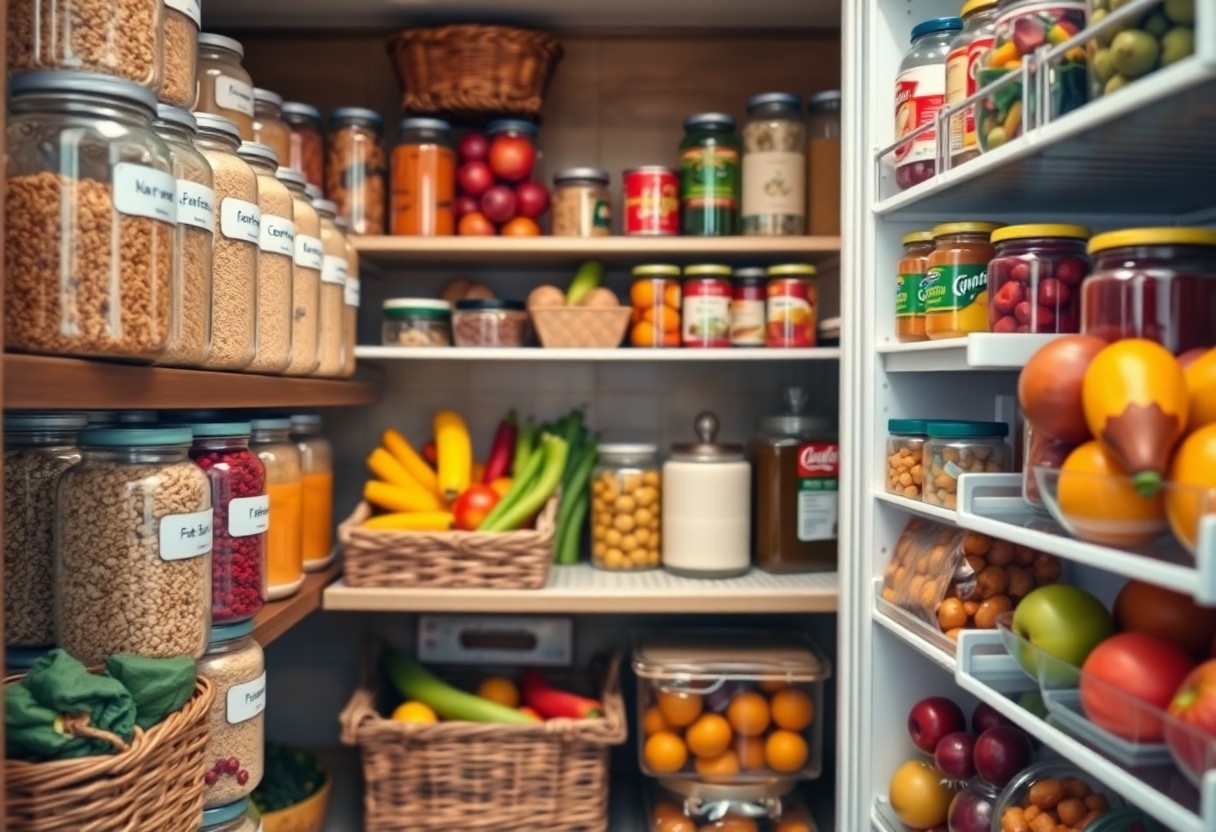Groceries can spoil quickly if you don’t store them properly, leading to wasted money and food. To extend the life of your produce, meats, and dairy, you must understand the best storage techniques for each category. Keeping your items in the correct temperature and humidity will ensure maximum freshness and nutritional value. In this guide, you’ll discover practical tips that help you take control of your kitchen and enjoy your groceries for longer.

Understanding Freshness Factors
- Temperature control
- Humidity management
- Airflow optimization
- Light exposure
Thou must consider multiple factors to maintain maximum freshness of your groceries, including temperature, humidity, and exposure to light.
Temperature Control
Maintaining the right temperature for your groceries is vital for preserving their integrity. Most perishables thrive at specific ranges, with refrigeration for items around 32°F to 40°F. A detailed breakdown is as follows:
Temperature Guidelines
| Food Type | Recommended Temperature |
| Dairy | 32°F to 40°F |
| Meat | 28°F to 32°F |
| Fruits | 32°F to 35°F |
| Vegetables | 32°F to 36°F |
Humidity Management
Proper humidity levels play a significant role in the storage of various vegetables and fruits. A balance between too dry and too moist can drastically affect freshness. For leafy greens, a moisture content near 95% is ideal, while mushrooms prefer drier conditions. Utilize crisper drawers with humidity controls to optimize your storage.
Maintaining the right humidity not only prevents spoilage but also enhances the overall quality of your food. Ensure that leafy produce stays wrapped in damp paper towels, while also venting containers in the fridge for items like tomatoes to avoid sogginess. Thou will find that a little attention to humidity levels goes a long way in extending the life of your groceries.

Proper Storage Techniques
Utilizing proper storage techniques can significantly prolong the freshness of your groceries. Focus on organizing your pantry, refrigerator, and freezer effectively. For comprehensive tips, refer to How to Store All Your Food So It Lasts Longer.
Pantry Staples
Store pantry staples like grains, pasta, and spices in airtight containers to protect them from moisture and pests. Keep your pantry at a stable temperature, ideally between 50°F and 70°F. Label containers with purchase dates to monitor freshness and use the oldest items first.
Refrigerated Items
Your refrigerator should maintain a temperature at or below 40°F to inhibit bacterial growth. Store fruits and vegetables in separate bins to avoid ethylene gas interference. Keep dairy products on the middle shelves, preferably in their original packaging, for optimum freshness.
Refrigerated items remain fresh longer when organized thoughtfully. For instance, use the “first in, first out” method when placing new items behind older ones. Avoid overcrowding to ensure cold air circulation and maintain consistent temperatures. Certain items, like tomatoes and potatoes, should be kept out of the fridge to preserve their taste and texture. Additionally, use moisture-absorbing produce bags for leafy greens to minimize excess moisture, which accelerates spoilage.

Organizing Your Grocery Items
Efficient organization of your grocery items ensures that everything is easy to find and remains fresh longer. Group similar items together, placing proteins on higher shelves and separating fruits and vegetables to prevent cross-contamination. Utilize bins or baskets for smaller items, and always keep frequently used ingredients at the front of the pantry or refrigerator for quick access. Consider arranging by expiration date or type to streamline meal prep and reduce food waste.
FIFO Method (First In, First Out)
The FIFO method is an effective strategy for managing food inventory. Place newer purchases behind older ones, ensuring that you use the items that have been in your fridge or pantry the longest first. This technique minimizes spoilage and waste, allowing you to maximize freshness and save money on groceries.
Labeling and Dates
Labeling food containers with purchase dates helps in tracking freshness and managing leftovers. Use a waterproof marker or labels to note when items were bought or opened, and consider adding expiration dates. This practice ensures you consume products within their optimal time frame and reduces the chances of eating spoiled food.
By maintaining clear labeling, you’ll easily identify which items require immediate attention. This is particularly useful for ingredients like meats, dairy, and perishable produce that have shorter shelf lives. Create a system where you check these dates weekly, allowing timely consumption and decreasing the likelihood of forgotten foods at the back of your fridge. Regular assessments of your stocks can guide your meal planning and shopping habits, promoting a healthier kitchen environment and reducing waste significantly.
Tips for Specific Food Types
- Keep herbs in water, like cut flowers.
- Store berries unwashed, in a paper towel.
- Wrap cheese in parchment paper, not plastic.
- Freeze meats in vacuum-sealed bags.
- Organize fridge by type for easy access.
| Food Type | Storage Method |
| Herbs | Keep in water |
| Berries | Store unwashed |
| Cheese | Wrap in parchment |
| Meat | Freeze in vacuum bags |
| Vegetables | Store in crisper drawer |
Fruits and Vegetables
Fruits and vegetables benefit from separate storage conditions to retain their freshness. Store ethylene-producing fruits, like apples and bananas, away from vegetables to prevent premature spoilage. Leafy greens thrive in a breathable container lined with a damp towel, which extends their crispness. Keeping items at optimal humidity levels in the crisper drawer further slows aging. This separation method maximizes shelf life and maintains quality.
Dairy and Meats
For dairy and meats, temperature control is crucial for maintaining freshness and preventing bacterial growth. Keep dairy products on the middle shelf, away from the fridge door, and ensure they are tightly sealed to avoid absorbing odors. Store raw meats at the bottom of the fridge in leak-proof containers to prevent contamination. This segment of your grocery haul requires particular care, as spoiled dairy and meats can lead to significant health risks.
To ensure optimal safety, dairy should ideally be consumed before the expiration date, but with proper storage, many items can remain fresh for an extended period. For example, hard cheeses can last up to six months when properly wrapped, while processed cheeses can stay fresh up to eight months. Fresh meats should be used within a few days or frozen to extend their life. Utilizing airtight containers and vacuum sealing can prevent freezer burn for meats, preserving flavor and texture when kept for longer periods.
Common Storage Mistakes to Avoid
Many people inadvertently shorten the lifespan of their groceries by making common storage mistakes. Identifying and correcting these errors can make a significant difference in maintaining freshness and reducing waste. Pay attention to how you organize your items and select the right containers to keep your food in optimal condition.
Overcrowding
Overcrowding your fridge or pantry prevents air circulation and can lead to uneven temperatures. Foods in the back may spoil faster due to lack of airflow. Aim to leave space between items, allowing cold air to circulate in the refrigerator and ensuring that each item remains properly chilled.
Incorrect Container Use
Using the wrong containers can lead to premature spoilage. For example, airtight containers may be suitable for dry goods, but fruits and vegetables often require breathable storage to prevent moisture buildup, which leads to mold. Always choose containers that suit the specific storage needs of your food items.
In particular, glass or mesh containers work well for items that need ventilation, like herbs and certain fruits, as they allow moisture to escape while maintaining humidity levels. Avoid sealing produce in non-breathable plastic, which can trap moisture and accelerate decay. For bulk items, use food-safe containers made of BPA-free materials to ensure longevity and safety. Choosing the right container enhances freshness and reduces waste, providing a better storage solution for your groceries.
Utilizing Technology for Freshness
Organizing Your Refrigerator To Maximize Freshness is vital in maintaining your groceries. By leveraging technology, you can enhance freshness and reduce waste effectively. Smart devices, such as temperature monitors in your refrigerator, provide real-time data to ensure optimal conditions for your food. Additionally, various apps allow you to stay informed about the status of food items, helping you track what’s in your pantry while keeping your groceries fresh.
Smart Home Devices
Smart home devices, like Wi-Fi-connected refrigerators, alert you to temperature changes or food spoilage. These innovations can help you maintain an ideal environment for perishables, ensuring your fruits, vegetables, and dairy products last longer. Some models even come equipped with cameras, allowing you to see inside your fridge remotely, which aids in smart shopping and reduces impulse purchases.
Apps for Expiration Tracking
Expiration tracking apps simplify keeping tabs on your groceries, sending notifications before items go bad. With features such as scanning barcodes, you can instantly add items to your inventory. Many apps also generate shopping lists and recipes based on what you have on hand, which not only minimizes waste but also encourages meal planning.
Using expiration tracking apps effectively means you can customize notifications for different food types, alerting you days before items expire. Some advanced options even provide suggestions on how to utilize those items in your meals, promoting creativity in cooking and maximizing your groceries’ potential. This proactive approach significantly cuts down on food waste and saves you money.
To wrap up
Conclusively, properly storing your groceries can significantly extend their freshness and prevent waste. Utilize the right containers, set your refrigerator to optimal temperatures, and organize items based on their specific storage needs. By following these guidelines, you ensure that your food retains its quality and flavor longer. For additional tips, refer to A Comprehensive Guide to Keeping Foods Fresher Longer.
FAQ
Q: How should I store fruits and vegetables to maximize freshness?
A: Store fruits and vegetables in separate drawers in the refrigerator. Keep ethylene-producing fruits like apples and bananas away from vegetables. Use breathable produce bags to allow airflow while keeping humidity in control.
Q: What is the best way to store dairy products?
A: Keep dairy products in the coldest part of the refrigerator, usually near the back. Avoid storing them in the door, as temperatures fluctuate more there. Seal containers tightly after use to prevent contamination and absorption of odors.
Q: How should I store bread to keep it from going stale?
A: Store bread in a cool, dry place, preferably in a bread box or a paper bag to allow for airflow. For longer storage, consider freezing sliced bread in a freezer-safe bag and toasting slices as needed.
Q: What is the proper method for storing meat and poultry?
A: Store raw meat and poultry in the coldest part of the refrigerator, ideally on the bottom shelf to avoid drips contaminating other foods. Use airtight containers or well-sealed plastic wrap to minimize exposure to air and moisture.
Q: How can I keep leftovers fresh for as long as possible?
A: Allow leftovers to cool down before refrigerating them in airtight containers. Label with dates to track freshness. Consume within 3-4 days or freeze for longer storage, ensuring to use freezer-safe containers.